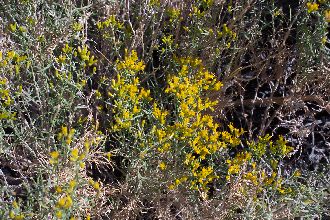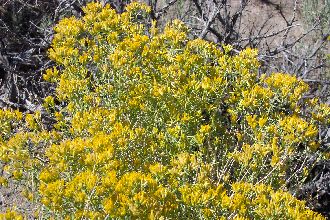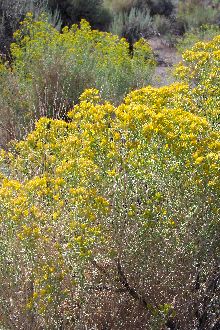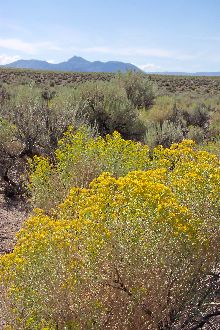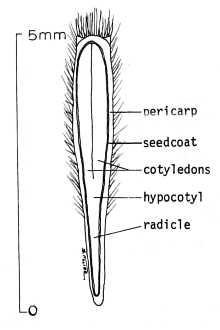Yellow Rabbitbrush
Scientific Name: Chrysothamnus viscidiflorus (Hook.) Nutt.
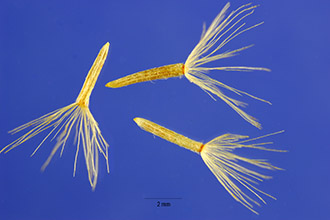
| General Information | |
|---|---|
| Usda Symbol | CHVI8 |
| Group | Dicot |
| Life Cycle | Perennial |
| Growth Habits | Shrub |
| Native Locations | CHVI8 |
Plant Guide
Alternate Names
Crinitaria viscidiflora Hooker Ericameria viscidiflora (Hook,) L, Use soil moisture sensors to measure the soil moisture of Yellow Rabbitbrush.,C, Anderson Douglas rabbitbrush Green rabbitbrush Low rabbitbrush Sticky-leaf rabbitbrush Viscid rabbitbrush
Uses
Wildlife and livestock: Yellow rabbitbrush is browsed by large game and livestock. It is considered desirable fall forage for cattle, sheep, horses, elk and antelope, and spring forage for deer (Ogle and Brazee, 2009). It is a valuable forage especially during late fall and early winter after more desirable forage has been utilized (Tirmenstein, 1999). Palatability and usage vary between subspecies of yellow rabbitbrush (McArthuer et al., 1979). Yellow rabbitbrush provides cover and nesting habitat for sage-grouse, small birds and rodents (Gregg et al., 1994). Black-tailed jackrabbits consume large quantities of yellow rabbitbrush during winter and early spring when plants are dormant (Curie and Goodwin, 1966). Yellow rabbitbrush provides late summer and fall forage for butterflies. Unpublished field reports indicate visitation from bordered patch butterflies (Chlosyne lacinia), Mormon metalmark (Apodemia mormo), mourning cloak (Nymphalis antiopa), common checkered skipper (Pyrgus communis), and Weidemeyer’s admiral (Limenitis weidemeyerii). Restoration: Yellow rabbitbrush is a seral species which colonizes disturbed areas making it well suited for use in restoration and revegetation plantings. It can be established from direct seeding and will spread via windborne seed. It has been successfully used for revegetating depleted rangelands, strip mines and roadsides (Plummer, 1977).
Status
Please consult the PLANTS Web site and your State Department of Natural Resources for this plant’s current status (e.g., threatened or endangered species, state noxious status, and wetland indicator values).
Description
General: Sunflower family (Asteraceae). Yellow rabbitbrush is a low- to moderate-growing shrub reaching mature heights of 20 to 100 cm (8 to 39 in) tall. The stems can be glabrous or pubescent depending on variety, and are covered with pale green to white-gray bark. The leaves are narrow and linear to oblong 1 to 6 cm (0.4 to 2.4 in) long and 0.5 to 8 mm (0.02 to 0.3 in) wide and often appear twisted. The flowers heads are borne in numerous compact to open terminal cymes. The flower heads are 5 to 7.5 mm (0.2 to 0.3 in) long and 2 to 4 mm (0.08 to 0.16 in) wide with glandular or pubescent bracts. The individual flowers are yellow 4 to 6 mm (0.16 to 0.25 in) long, producing a 4 mm (0.16 in) long, hairy achene (Welsh et al., 2003). There are five recognized varieties of yellow rabbitbrush including varieties planifolius, lanceolatus, puberulus, axillaris and viscidiflorus which can be distinguished by leaf morphology, stem pubescence and distribution. Flora of North America (1993+) provides a taxonomic key for the separation of varieties.
Ethnobotany
Yellow rabbitbrush has been used by a variety of Native American peoples. Paiute Indians used yellow rabbitbrush to treat colds and coughs (Kelly, 1932), and the Hopi Indians used yellow rabbitbrush as a dermatological aid (Fewkes, 1896). The Gosiute and Paiutes used the latex from the roots as a chewing gum (Chamberlin, 1911; Mahar, 1953). Hopi and Navajo people used the flowers to create orange and yellow dye (Colton, 1974; Elmore, 1944). Distribution: Yellow rabbitbrush is native to western North America. It has been found from British Columbia, south to California and east to Nebraska, Colorado, Montana and New Mexico. For current distribution, please consult the Plant Profile page for this species on the PLANTS Web site. Habitat: Yellow rabbitbrush occurs in desert to semi-desert habitats in western rangelands. It is commonly associated with other rabbitbrush species (Chrysothamnus and Ericameria spp.) and sagebrush species (Artemisia spp.). Other associates include broom snakeweed (Gutierezi sarothrae), shadscale (Atriplex confertifolia), and winterfat (Krascheninnikovia lanata). Yellow rabbitbrush can also be found growing in pinyon-juniper (Pinus-Juniperus woodlands). Yellow rabbitbrush and other rabbitbrush species are often subdominant in sagebrush communities with rabbitbrush densities quickly increasing after heavy disturbance and then decreasing with time as sagebrush densities increase (Young and Evans, 1974). Al Schneider @ USDA-NRCS PLANTS Database
Adaptation
Yellow rabbitbrush is adapted to coarse to medium well-drained soils in areas receiving (7 to 24 in) mean annual precipitation. It has fair salt tolerance and will grow in soils with a pH range 7.0 to 8.5 (USDA-NRCS, 2012). It is found at middle to high elevations from 800 to 3,350 m (2,600 to 11,000 ft) (Hitchcock and Cronquist, 1973).
Establishment
Yellow rabbitbrush does not exhibit dormancy and do not persist in the soil seed bank (James et al., 1991). Field establishment of yellow rabbitbrush is typically achieved with nursery grown plants or with fall dormant seedings. Seed should be broadcast or shallow drilled to no more than 3 mm (0.125 in) depth. The pure stand seeding rate is 0.5 lb/ac. For rangeland seedings the recommended rate in mixes is approximately 1/40 of a pound PLS per acre (Ogle et al., 2011). There are approximately 733,000 seeds/lb (USDA-NRCS, 2012). Bareroot and containerized materials can be transplanted in the fall or spring (McArthur and Stevens, 1994).
Management
Yellow rabbitbrush increases with overgrazing and is difficult to completely control (Whitson et al., 1996). It is susceptible to 2,4-D during periods of active growth and available moisture when herbicides will be translocated through the tissues to the dormant buds in the crown (James et al., 1991). Top removal practices such as mowing and burning are ineffective due to yellow rabbitbrush’s ability to resprout from crown buds (James et al., 1991). If management objectives are to reduce yellow rabbitbrush, fire treatment is not generally recommended as it may result in the species becoming dominant.
Pests and Potential Problems
Mature yellow rabbitbrush plants are susceptible to infestations of the larvae of hairy yellow-marked buprestid (Acamaeodera pulchella) which bore tunnels through the stems resulting in plant death (Young and Evans, 1974).
Environmental Concerns
Concerns
Concerns
Yellow rabbitbrush will spread and can become weedy under high grazing and disturbance (Whitson et al., 1996).
Control
Please contact your local agricultural extension specialist or county weed specialist to learn what works best in your area and how to use it safely. Always read label and safety instructions for each control method. Trade names and control measures appear in this document only to provide specific information. USDA NRCS does not guarantee or warranty the products and control methods named, and other products may be equally effective.
Seeds and Plant Production
Plant Production
Plant Production
Seed can be collected by hand with racquets and hoppers, or mechanically with vacuum type harvesters, flail vacs and other seed strippers. Yellow rabbitbrush seed is difficult to clean and low purity levels are common in seed lots. Jorgensen and Stevens (1994) list acceptable purities of 10 to 15 percent. Long term seed storage of yellow rabbitbrush has been problematic. Seed viability of rubber rabbitbrush dropped from 80 to 14% when stored under dry storage conditions from the second to fifth year in storage (James et al., 1991). Steve Hurst @ USDA-NRCS PLANTS Database Cultivars, Improved, and Selected Materials (and area of origin) Wildland collected seed is available from commercial sources. There are currently no commercial releases of yellow rabbitbrush.
References
Chamberlin, R.V. 1911. The ethno-botany of the Gosiute Indians of Utah. Memoirs of the American Anthropological Association. 2(5): 331-405. Colton, H.S. 1974. Hopi History and ethnobotany. In: D.A. Horr (ed.) Hopi Indians. Garland. New York. Elmore, F.H. 1944. Ethnobotany of the Navajo. Santa Fe, NM. School of American Research. Flora of North America Editorial Committee, eds. 1993+. Flora of North America North of Mexico. 16+ vols. New York and Oxford. Gregg, M.A., Crawford, J.A., Drut, M.S., and A.K. DeLong. 1994. Vegetational cover and predation of sage grouse nests in Oregon. Journal of
Wildlife
Management. 58(1): 162-166. Fewkes, J.W. 1896. A contribution to Ethnobotany. American Anthropologist. 9: 14-21. Hitchcock, C.L., and A. Cronquist. 1973. Flora of the Pacific Northwest: an illustrated manual. University of Washington Press. Seattle, Washington. 730p. James, L.F., Evans, J.O., Ralphs, M.H., and R.D. Child. 1991. Noxious Range Weeds. Westview Press, Boulder, CO. 466p. Kelly, I.T. 1932. Ethnography of the Surprise Valley Paiute. University of California Publications in American Archaeology and Ethnology. 31(3): 67-210. Jorgensen, K.R., and R. Stevens. 1994. Seed collection, cleaning, and storage. In: S.B. Monsen, R. Stevens, and N.L. Shaw [compilers]. Restoring western ranges and wildlands. Fort Collins, CO: USDA Forest Service, Rocky Mountain Research Station.
General
Technical Report RMRS-GTR-136-vol-3. p. 699-717. Mahar, J.M. 1953. Ethnobotany of the Oregon Paiutes of the Warm Springs Indian Reservation. Reed College, B.A. Thesis. McArthur, E.D., Blauer, C.C., Plummer, A.P., and R. Stevens. 1979. Characteristics and hybridization of important Intermountain shrubs. III. Sunflower family. Res. Pap. INT-220. Ogden, UT: USDA-Forest Service, Intermountain Forest and
Range
Experiment Station. 82p. McArthur, E.D., and R. Stevens. 2004. Composite Shrubs. In: S.B. Monsen, R. Stevens, and N.L. Shaw [compilers]. Restoring western ranges and wildlands. Fort Collins, CO: USDA Forest Service, Rocky Mountain Research Station. General Technical Report RMRS-GTR-136-vol-2. p. 425-491. Ogle and Brazee. 2009. Technical Note 3: Estimating Initial Stocking Rates. USDA-NRCS, Boise, ID. 11p Ogle, D., St. John, L., Stannard, M., and L. Holzworth. 2011. Technical Note 24: Conservation plant species for the Intermountain West. USDA-NRCS, Boise, ID-Salt Lake City, UT-Spokane, WA. ID-TN 24. 57p. Tirmenstein, D, 1999. Chrysothamnus viscidiflorus. In: Fire Effects Information System, [Online]. USDA-Forest Service, Rocky Mountain Research Station, Fire Sciences Laboratory (Producer). Available: http://www.fs.fed.us/database/feis [Arpil 9, 2012]. [USDA NRCS] USDA Natural Resources
Plant Traits
Growth Requirements
| Temperature, Minimum (°F) | -23 |
|---|---|
| Adapted to Coarse Textured Soils | Yes |
| Adapted to Fine Textured Soils | No |
| Adapted to Medium Textured Soils | Yes |
| Anaerobic Tolerance | None |
| CaCO3 Tolerance | High |
| Cold Stratification Required | No |
| Drought Tolerance | High |
| Fertility Requirement | Low |
| Fire Tolerance | None |
| Frost Free Days, Minimum | 160 |
| Hedge Tolerance | High |
| Moisture Use | Low |
| pH, Maximum | 8.5 |
| pH, Minimum | 7.0 |
| Planting Density per Acre, Maxim | 3000 |
| Planting Density per Acre, Minim | 700 |
| Precipitation, Maximum | 24 |
| Precipitation, Minimum | 7 |
| Root Depth, Minimum (inches) | 14 |
| Salinity Tolerance | Medium |
| Shade Tolerance | Intolerant |
Morphology/Physiology
| Bloat | Low |
|---|---|
| Toxicity | None |
| Resprout Ability | Yes |
| Shape and Orientation | Erect |
| Active Growth Period | Spring and Summer |
| C:N Ratio | High |
| Coppice Potential | Yes |
| Fall Conspicuous | No |
| Fire Resistant | No |
| Flower Color | Yellow |
| Flower Conspicuous | Yes |
| Foliage Color | Green |
| Foliage Porosity Summer | Moderate |
| Foliage Porosity Winter | Moderate |
| Foliage Texture | Fine |
| Fruit/Seed Conspicuous | Yes |
| Nitrogen Fixation | None |
| Low Growing Grass | No |
| Lifespan | Short |
| Leaf Retention | No |
| Known Allelopath | No |
| Height, Mature (feet) | 3.0 |
| Height at 20 Years, Maximum (fee | 3 |
| Growth Rate | Moderate |
| Growth Form | Multiple Stem |
| Fruit/Seed Color | Brown |
Reproduction
| Vegetative Spread Rate | None |
|---|---|
| Small Grain | No |
| Seedling Vigor | Medium |
| Seed Spread Rate | Rapid |
| Fruit/Seed Period End | Fall |
| Seed per Pound | 732643 |
| Propagated by Tubers | No |
| Propagated by Sprigs | No |
| Propagated by Sod | No |
| Propagated by Seed | Yes |
| Propagated by Corm | No |
| Propagated by Container | Yes |
| Propagated by Bulb | No |
| Propagated by Bare Root | Yes |
| Fruit/Seed Persistence | Yes |
| Fruit/Seed Period Begin | Summer |
| Fruit/Seed Abundance | High |
| Commercial Availability | Routinely Available |
| Bloom Period | Spring |
| Propagated by Cuttings | Yes |
Suitability/Use
| Veneer Product | No |
|---|---|
| Pulpwood Product | No |
| Protein Potential | Low |
| Post Product | No |
| Palatable Human | No |
| Palatable Graze Animal | Low |
| Palatable Browse Animal | Low |
| Nursery Stock Product | No |
| Naval Store Product | No |
| Lumber Product | No |
| Fodder Product | No |
| Christmas Tree Product | No |
| Berry/Nut/Seed Product | No |

